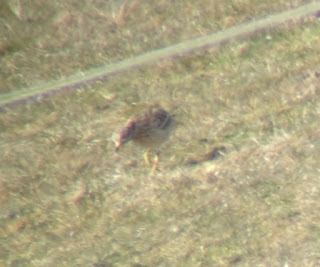Ring Ouzel, Southwell, Portland 6.4.13
With news of five stone-curlews at Butterstreet Cove, we rushed over there. After about 45 minutes of searching, we found them- six of them! This number of stone-curlews together in Dorset is unprecedented- part of a mini-influx across the south of the country right now. It was my first of the species, although they bear a great resemblance to the spotted dikkops I see in Kenya. Their British population decreased by 85% between the 1940s and 1980s- but thanks to the RSPB, their numbers are now slowly increasing. This mini-influx is certainly a promising sign. Unfortunately they were too distant for any decent photos, but I'm not complaining!
I know- it's shockingly bad, but it was the only photo I got of it that was recognisable as a stone-curlew!
In the field with them was a wheatear, and nearby some linnets, and two overdue year-ticks in shelduck and redshank.
We then headed to Lodmoor, where we failed to locate the spoonbills, but did find four little ringed plovers (again part of a small influx currently in the south of England), and our first swallow of the year. That, combined with the song of chiffchaffs, gave a real sense of spring having finally arrived.
At Radipole, we found the hooded merganser immediately- debate over whether the bird is genuinely wild will never end, but my view is that it is wild. We failed to find the garganey at North Hide, and overall, there were very few birds around. The best we could find were two singing willow warblers, and two more swallows over, along with dozens of sand martins.
.JPG)

.JPG)
No comments:
Post a Comment